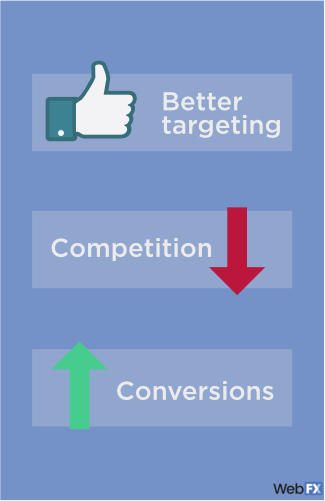Long-Tail SEO: What Is Long-Tail SEO and How Can You Use It?
That’s why it’s critical to know what long-tail SEO is, plus how to build a long-tail SEO strategy.
Ready to learn everything about long-tail SEO? Keep reading to get the inside scoop — or, speak to one of our award-winning specialists about developing a custom long-tail SEO strategy for your business by contacting us online or calling us at 888-601-5359!
WebFX can help you with all of your long-tail SEO needs.
Independent research from Clutch has named WebFX the
top SEO company in the United States.
Clutch has personally interviewed more than 250 WebFX clients to discuss their experience partnering with us.
Read More Clutch Reviews

What is long-tail SEO?

Long-tail SEO is a technique for generating high-value organic website traffic. It targets long-tail keywords, which are search terms that consist of three or more words. They also have a lower search volume and competition rate, as well as a higher conversion rate than short-tail keywords.
What are long-tail keywords?
Long-tail keywords contain three or more words. In comparison to short-tail keywords, which consist of one to two words, long-tail keywords target broad concepts and user intents. As a result, long-tail keywords have a low search volume, competition rate, and cost-per-click (CPC).
Why do marketers call them long-tail keywords?
If you plotted the search volume of long-tail and short-tail keywords on a graph, your long-tail keywords would appear at the “tail-end” of your graph due to their low search volume — and they’d create a visual that looks like a tail, especially against the high search volume of short-tail keywords.
What’s an example of a long-tail keyword, though?
Imagine that someone searches for, “nonprofit organizations.” A variety of intents encompass that search, from wanting to donate, volunteer, or work with a nonprofit organization. A similar example is the search, “marketing tips,” which could include tips for content marketing, email marketing, and more.
These keywords — nonprofit organizations and marketing tips — are short-tail keywords.
Join them together, into, “marketing tips for nonprofit organizations,” and there is a clear intent. The searcher wants to find marketing tips that apply to nonprofit organizations. That’s why this keyword is an example of a long-tail keyword.
What is a long-tail SEO strategy?
A long-tail SEO strategy focuses on targeting long-tail keywords and optimizing your website for those keywords. This strategy offers a smarter focus — you’re optimizing your site for target keywords that offer the most value to your business.
If you’re the owner of an HVAC business in Chicago, for example, you may target these keywords:
- “emergency ac repair chicago”
- “how to maintain hvac system”
- “how often should you clean your air ducts”
- “how often should you clean your furnace”
As you can tell, these long-tail keywords encompass several different intents. The first is transactional — these searchers are looking for immediate HVAC services in their area. The following examples, however, are informational — these users are researching how and when to maintain their HVAC system.
That’s why a long-tail SEO strategy focuses not only on optimizing your primary webpages, but also expanding your website with fresh content, like blog posts and guides.

5 powerful reasons to use long-tail SEO
Around 70 percent of all search traffic comes from long-tail keywords. So, if you’re not targeting long-tail keywords in your SEO strategy, you’re missing out on valuable traffic from consumers in your target audience.
Why else should you use long-tail SEO? Here are five of the most compelling reasons:
1. Reach yoru target audience faster
If you want to reach your target audience sooner, rather than later, long-tail SEO can help. In comparison to short-tail keywords, long-tail keywords focus on the specific intent or motivation behind a search.
For example, the short-tail keyword, “hvac system,” has several motivations behind it, including:
- What is an HVAC system?
- What types of HVAC systems are there?
- What is the average price for an HVAC system?
- What are the components of an HVAC system?
- Who sells an HVAC system?
- And more
In comparison, the long-tail keyword, “types of hvac systems,” has a specific goal behind it. The searcher wants to learn about the different types of HVAC systems, which makes it easier for your team or digital marketing agency to develop content in your long-tail SEO strategy that answers this search query.
As a result, it’s beneficial for your business to look at the motivations behind different keywords, like the types of HVAC systems. By focusing on long-tail keywords, you’re connecting with users that know what they want.
2. Decrease search competition
When a keyword has several different intents — or even multiple meanings — it often has a higher level of competition. That makes it tough for your company to compete, and for a keyword that may not even drive the results you want, like a call for a quote or a sign-up for your email newsletter.
It’s also worth mentioning that you’ll not only compete against competitors but also companies in different industries if that keyword has a range of meanings. One example is the keyword, “fencing,” which can refer to a sport or a barrier.

As long-tail keywords feature fewer searches and narrower intents, they’re less competitive. The competition that you do have may not even optimize their website for search engines and users, which means you’ll have less of a challenge when it comes to outranking them.
The result?
Your website ranks on the first page of search results for low-competition, high-value keywords.
3. Improve your conversion rates

When a site is irrelevant to a user’s search, they won’t click on it.
For example, a user that’s looking for a fencing company, but starts their search with the keyword, “fencing,” won’t visit your website if you’re an instructor for the sport. In this scenario, you’re optimizing your website for a competitive keyword that isn’t even driving results.
Even if you do earn some traffic and leads from short-tail keywords, they’re likely less than what you’d earn by focusing on long-tail SEO. Studies prove it too, with long-tail keywords offering a conversion rate of more than 35 percent.
By optimizing your website for more relevant search terms, you’re competing and ranking for the keywords that offer the most value to your business. Even better — you’ll position yourself as an industry leader.
That leads to more traffic — and more conversions.
4. Lower your digital marketing costs
Compared to long-tail keywords, short-tail keywords are a massive investment. Their high search volume and competition means tons of other businesses want to rank for that keyword — which means your team needs to invest more time to earn and maintain rankings.
It’s more than your team’s time that you’re investing, however. It’s also your money.
With long-tail SEO, you can lower your digital marketing costs. While your team — or digital marketing agency — will still need to research and compete for long-tail keywords, they’ll have less competition. That makes optimizing and maintaining your ranking in search results easier.
The best part is that you’re investing your time in keywords that offer higher conversion rates. That translates to a bigger return on investment (ROI), which your business can use to grow your SEO strategy or services.
5. Adapt your strategy to user trends

By adopting a long-tail SEO strategy, you’ll also stay up-to-date on user trends, like voice search. With voice search, users naturally make long-tail search queries, such as when searching for a nearby restaurant.
If you focus all your SEO efforts on short-tail keywords, your company won’t connect with these consumers. That can lead to substantial losses in revenue, especially if you’re a local business as 80 percent of all local searches, whether with short- or long-tail keywords, convert.
Include long-tail keywords in your SEO strategy, and you can ensure you reach your target audience.
4 steps for developing an effective long-tail SEO strategy
Are you ready to use long-tail SEO in your company’s strategy? Learn how in four simple steps:
1. Conduct keyword research
The first step in developing a long-tail SEO strategy focuses on keyword research — and it’s one of the most critical parts to long-tail SEO. Optimize your website for keywords that your target audience isn’t using, and you won’t drive the results you want.
How do you discover those keywords, though? Try these strategies:
- Browse popular forums: Your target audience can tell you a lot about what they want to know. Via Quora, Reddit, Facebook, and other platforms, you can learn what consumers and businesses want to know. Maybe, for example, they’re interested in learning about how to repair a certain type of fence, which is a topic you can cover in a blog post on your website.
- Use keyword research tools: One of the best ways to find long-tail keywords is with keyword research tools. You have plenty of options to choose from, including KeywordsFX, Answer the Public, io, BuzzSumo, and more. In most cases, you’ll use each of these tools to build a set of long-term keywords to target.
- Chat with customers: Conversations with your customers can also help generate keywords for your long-tail SEO strategy. A few topics of discussion include asking them how they like the product or what questions they have about it. To earn feedback from a variety of clients, think about sending a survey.
- Look at competitors: It’s vital that you create an original strategy for your long-tail SEO. It’s also important, however, that you look at how your competitors approach their SEO. Their strategies can provide you with insight and ideas for yours. Plus, a competitor analysis keeps you up-to-date on how these companies earn their customers.
As you compile these keywords, organize them in an Excel document or Google Sheet. If you’re using keyword research tools — which you should — many allow you to download your keyword data into a Google Sheet or Excel file.
2. Match terms to content
In coordination with your long-tail SEO strategy, you’ll optimize not only existing content on your website but also create new content for it. That means you’ll need to match long-tail keywords to current and future content.
For example, if you’re an HVAC company, you may create the following action plan:
- Divide your core service page into sub-divisions for each service
- Optimize your emergency services page to rank higher for a long-tail keyword
- Develop your content calendar for your company blog and select long-tail keywords
As you optimize existing webpages and create new ones, make sure that you create original and high-quality content for each keyword. Consider the experience and intent of your users too — otherwise, you may see a drop in your search result rankings, plus the loss of valuable leads.
By adopting this approach, you’ll make the most of your long-tail SEO strategy.
3. Optimize and create content

In this step of developing a long-tail SEO strategy, many businesses struggle. If you’re unfamiliar with SEO, as well as the standards of search engines, like Google, Bing, and Yahoo, it’s easy to over-optimize your content, such as with keyword stuffing.
That’s why it’s helpful to partner with a digital marketing agency that specializes in SEO — a full-service agency like WebFX is even better as we can provide copywriting services to ensure your website copy adheres to the standards of Google and other search engines.
If you’re optimizing your copy in-house, however, focus on the following areas:
- Title tag: In search results, it’s your title tag that shows — not your designated H1 heading. You can see an example of this below, as the title tag includes the name of the website, “Dengarden,” but the H1 heading in the story doesn’t. While your title tag doesn’t have to include your company name, it should include your long-tail keyword. It’s also critical that your title tag sticks to 60 characters. A title tag should also hook users, enticing them to click on your website.
- Meta description: The meta description of your webpage also displays in search results. While your title tag hooks audiences, your meta description should convince them to click on your website — it serves as a summary of your webpage. For the best optimization of your meta description, include your long-tail keyword at least once, and do not exceed 160 characters. If you’re targeting a few additional long-tail keywords, you can include them in your meta description too.
- Content: The content of your webpage provides an answer to a user’s search, such as how often they should clean their furnace. Optimize your content by including your long-tail keyword, which should feature in your heading and sub-headings too. It’s also critical that you make your content easy-to-read, so limit paragraphs to three or four lines.
- URL: In your long-tail SEO strategy, it’s also critical that you optimize your URLs. Like your title tag, your URL should feature your long-tail keyword. If you’re targeting the keyword, “how to clean furnace filter,” for instance, you may make your URL, “how-to-clean-furnace-filter.” Like this example, separate the words in your URL with a dash.
- Images: It’s critical to include videos or images on your webpages. They not only help optimize your webpage but also improve the viewing experience of users. If you incorporate images into your content, make sure to compress them with a tool like io. You should also include an appropriate filename — with dashes — and descriptive alt text.
Web content composed with the free online wysiwyg HTML editor. Please subscribe for a membership to remove promotional messages from the edited documents.
If you’re optimizing existing content on your website, you can always use a free SEO audit tool. This tool provides you with a report that details the strengths and weaknesses of your long-tail SEO strategy. It also offers recommendations for improvement.
4. Test and reoptimize
SEO is an ongoing strategy. That’s why, if you want to make the most of your long-tail SEO, you need to look for room to improve after launching your website’s newest or reoptimized webpages. If you don’t, it’s likely that your website will decrease in ranking for these high-value keywords.
To measure the success of your long-tail SEO strategy, look at several factors, including:
- Rankings: SEO focuses on improving your online visibility to search engines, so it makes sense to monitor the ranking of your website in search results for select keywords. It can take months, however, for your website to rank. That’s why it’s critical to give your strategy time, as well as measure other metrics.
- Traffic: While somewhat of a vanity metric, it is worth monitoring the traffic of your webpages. You can see which webpages drive the most traffic for your website, as well as monitor the source of that traffic. For example, you may notice that a lot of mobile users on the West Coast visit your website. That may lead your team to develop a mobile-friendly site.

- Revenue: One way to measure the success of your long-tail SEO strategy is through your revenue. If you partner with a digital marketing agency, like WebFX, we offer proprietary — and industry-leading — software for tracking your digital marketing ROI. As a result, we’ve tracked and generated more than $6 billion in sales for our clients.
- Conversions: Another metric that your team should monitor is your conversion rate. What qualifies as a conversion depends on your long-tail SEO goals, such as earning more newsletter subscribers or generating more online orders. If you’re targeting the right keywords and writing compelling copy, you should see a noticeable increase in conversions.
Track your performance on a regular basis to maximize the results of your long-tail SEO strategy.
Ready to improve your company’s long-tail SEO?
With more consumers relying on search engines to discover new products and services, it’s essential that your digital marketing strategy adapts. With a smart and competitive long-tail SEO strategy, you can reach the audiences that matter most to your company, leading to more revenue for your business.
Ready to start using long-tail SEO? WebFX can help. Contact us online today to speak with a strategist — or, give us a ring at 888-601-5359!
Related Resources
- How to Identify Quality Keywords
- How to Improve Your SEO Keyword Targeting with Motion Charts
- How to Map Keywords Across Your Website
- How to Rank Better for “Almost-There” Keywords
- Keyword Density Checker
- Keyword Density Checker Tool: How to Check Keyword Density for Free [+FAQ]
- Keywords Vs Search Queries
- Niche Keywords: 4 Steps for Conducting Niche Keyword Research
- What Are Keywords for SEO?
- Your Guide to How to Search for SEO Keywords
Marketing Tips for Niche Industries
- How to Build Links for Your Hotel Website
- How to Increase Higher Education Enrollment with SEO
- How Tutors Can Use SEO to Successfully Get Clients
- HVAC SEO Services
- Inside SEO for Transportation and Logistics Companies
- Law Firm SEO: Sign More Clients with Law Firm SEO Services
- Long Tail Keyword Strategies for Home Services Companies
- Long Tail Keywords for Real Estate
- Long Tail SEO Keywords for Medical Practices
- Search Engine Optimization (SEO) for Garage Door Companies


How Is Your Website's SEO?
Use our free tool to get your score calculated in under 60 seconds.










